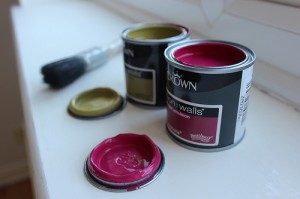 5 Steps to Paint a Wall Like a Pro
5 Steps to Paint a Wall Like a Pro
Don’t expect your first coat to look perfect: it won’t!
DESIGN TIP: KEEP A WET RAG IN YOUR POCKET TO CORRECT MISTAKES ALONG THE WAY
I think all of us can identify a paint job gone wrong with its drippy marks and spotty coverage. The first thing you should consider when painting a room is that you should allocate more than “a couple of hours” to do the job properly. You should expect to prep the room first on one day, and then the next tackle the actual painting. There is also a bit more to a good paint job than just slapping some paint on a wall.
Generally, most walls need to be sanded down and sometimes scraped. By sanding, the wall becomes scuffed up a little in order for the paint to grab hold of the surface, and scraping will remove any old imperfections. Additionally, if there are any spots with greasy buildup or dust, a good washing can be of use. If you’re painting new walls or working over patched surfaces, you’ll need to prime the surface, which evens out the walls with a solid base. Investing in a good angled brush will eliminate the need to tape, and is a better solution so that when you are painting you do not bleed under the tape or peel the paint off when you remove it. For a top quality job, expect to sand after applying primer, and additionally after every coat of paint.
STEP 1. SET UP YOUR SPACE
Remove any art on the walls, put your furniture in the middle of the room. Use a canvas (not plastic, less absorbent) tarp to cover it, and use painters tape to fasten the edges of the tarp. Unscrew and remove any electrical covers and tape over the fixtures themselves. Make sure to cover or tape anything that can’t be removed (like wall sconces).
STEP 2. PREP YOUR WALLS
Using a side to side motion, sand down the walls. Utilize a scraper to remove any other imperfections like previous paint drips. Wash down your walls with warm water and dish soap to remove any grime so that the paint sticks evenly when applied. Dry everything off, and make sure to remove any dust. Fill in any gaps or holes in the walls.
STEP 3. PREP YOUR EDGES & CORNERS
Using the aforementioned angled brush, cut in a 2-3″ swath of paint around all of the edges: against the ceiling, the corners of the room, against molding, against trim… whatever edges you have. This will save you from lovely rolling marks while you’re trying to fill in the squared off corners with a round roller, which doesn’t exactly work.
STEP 4. PAINT THE WALL
The paint roller should be utilized in an M or W formation across the wall to distribute your paint, then use overlapping vertical movements to evenly coat between the lines and the already established edges. Wait until dry, then repeat with second coat if necessary.
STEP 5. PAINT THE TRIM
A wide, straight edge brush will cover most of the broader moldings, while a 1-2 inch angled sash brush would be better suited to any smaller trim.